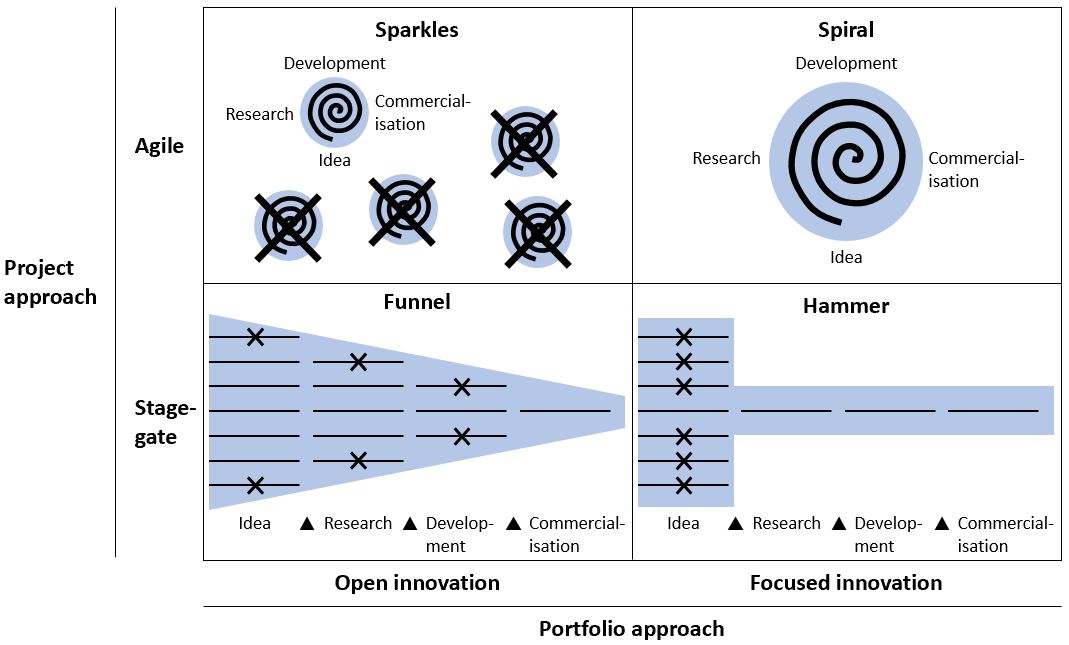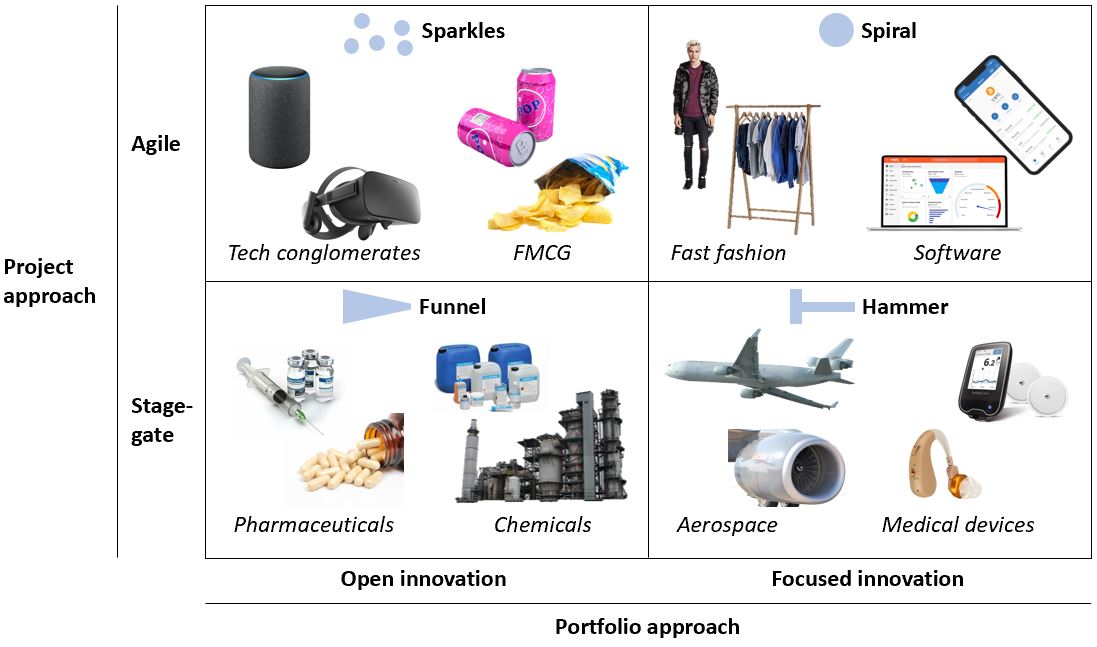With companies under increasing pressure to innovate, what is the most effective R&D approach for the future? We consider R&D key archetypes and strategic trends.
The Importance of Innovation and R&D
With firms competing on a global scale, and technological developments fuelling better quality products and increased customer expectations, a company’s R&D activities are vital to creating a pipeline of innovation capable of sustaining long term success.
A strong R&D programme can bring a whole range of benefits for a company if done correctly. It can help to develop new products to bring to the market and also build upon existing ones, with constant, iterative improvements turning a standard product into a potential market leader. As well as creating new products and optimising existing ones, a good R&D strategy can also help to reduce marginal costs and increase productivity by improving processes, attract investors searching for companies with strong growth potential and entice top talent looking to work in an innovative environment.
One of the biggest challenges’ companies face is how to organise and structure the R&D portfolio, and then how to approach and develop projects once they have been determined. In order to develop the most technologically innovative products and processes for the best possible value, companies are constantly looking to evolve their R&D approaches. This has led to a number of different R&D strategies developing across a multitude of industries, ranging from more focused and structured innovation, to open and agile methods, depending upon the industry and various other factors.
With some of those using more traditional R&D approaches exploring the development of new agile and dynamic processes, such as with the current experimentation of large pharmaceutical companies with agile approaches, what is the right balance between focused and structured R&D and open, agile innovation?
Different Approaches and Trends in R&D
Exhibit 1 below outlines the four major R&D approaches.

Exhibit 1: The 4 major approaches to R&D; Source: Oleto Associates experience
Funnel – open and stage-gate approach: The ‘Funnel’ follows a highly structured approach with various decision gates throughout the R&D process guiding product development. The approach enables companies to explore a plethora of ideas, methodically working through each one in order to test and discount the unviable concepts at various stages of the R&D process until a workable product/process is eventually landed upon. This is one of the most traditional approaches to R&D and is heavily associated with pharmaceutical and chemical companies.
Hammer – focused and stage-gate approach: This process begins with multiple ideas which are quickly evaluated in order to whittle down the number into only a few projects. Often the chosen projects focus on a very specific product type or area of interest to the company. The selected ideas are then driven forward in a highly structured way, with several decision gates in place allowing senior management to validate and direct the R&D process throughout. This approach is similar to the ‘Funnel’ but usually less expensive due to the pre-selection of ideas to be tested. It is most associated with companies who have a specialist area of product expertise, such as medical devices and aerospace.
Spiral – focused and agile approach: This approach advocates selecting an idea and developing it through ongoing iterations and sprints that enable constant improvements and rapid and flexible responses to change. Rather than a rigidly structured approach with decision gates allocated to key stages of development, the ‘Spiral’ has a more circular approach to research, development and commercialisation which accelerates the R&D process for a particular idea. This approach is used by software and fast fashion companies who need to be adaptive and reactive to the market.
Sparkle – open and agile approach: Arguably the least structured and most dynamic approach with minimal senior management control of the creative process. Like ‘Spiral’, it is highly focused on adaptive planning, continual improvements and the evolutionary development of ideas. The emphasis is placed on following creativity down whatever path it chooses and testing multiple ideas at once, each one being explored in a dynamic and evolutive process until it is discounted or turned into a viable commercial opportunity. Often ideas will metamorphose throughout the process or merge with one another. This approach is often taken by tech giants who have enormous resources, can afford failure and operate on the very edge of innovation. It is also used by large FMCG companies who are constantly developing, testing and releasing/terminating new products.

Exhibit 2: Examples of products developed while using the major R&D approaches; Source: Oleto Associates experience
Current trends show that many companies are increasingly turning towards more agile R&D approaches (moving upwards on the y-axis), as opposed to the more traditional stage gate methods. Examples of this can be seen with pharmaceutical and chemical companies who are increasingly utilising external partnerships, flexible research outsourcing and more agile project team structures to generate and test more ideas with greater speed and at lower costs. In addition, there is also a trend towards more focused innovation (to the right on the x-axis) due to the increasing costs of R&D, resulting in ongoing attempts to reduce the number of projects in portfolios. Pursuing a focused approach to innovation offers greater cost efficiency to companies with limited resources and enables them to zoom in on strategically relevant products faster than is often possible with more open R&D approaches.
However, for many, the ideal movement is from ‘Spiral’ to ‘Sparkle’. Requiring enormous resources and the ability to absorb high failure rates, this agile and open approach is heavily associated with the tech giants who often lead technological innovation and have the budgets necessary to run multiple R&D projects at the same time. Whilst costly, the opportunities created to develop cutting edge technology and products is enormous and why many aspire towards this approach.
What to Consider When Selecting a Strategic R&D Approach
As one can imagine, there is not one approach that fits all. Each R&D approach has its own strengths and weaknesses and companies must understand their own requirements, resources and industries in order to plan the correct modern R&D approach. Important things they must consider include:
-
Cost level: Companies must fully understand the level of cost involved in their R&D approach and what budget they have. More open approaches will incur greater costs as ideas are fully explored before being discounted or accepted, whereas more targeted ones will reduce costs by focusing efforts on fewer, closer aligned concepts.
-
Degree of industry regulation: If companies are operating in a highly regulated environment, such as healthcare, then R&D must follow certain set guidelines in order to create compliant products. This encourages a more structured approach to innovation. On the contrary, for industries that have very little regulation, the opposite is true and R&D approaches can be far more agile.
-
Appropriate R&D cycle: Companies need to consider the required speed of innovation. If a market is highly competitive and crowded, requiring R&D to take place at a faster pace (e.g., 6-12 months), then this will lead towards a more efficient R&D approach that generates and develops ideas quickly. Those who are restricted by regulations or able to develop products over a longer time period (e.g., 5+ years) may choose to adopt a more open innovation approach where multiple ideas can be explored comprehensively before being discounted or progressed.
-
Need for novel innovation: If creating completely new products is vitally important, then companies will favour a more open innovation R&D approach which places greater emphasis on idea generation. However, if the objective is to improve existing products then a more targeted approach can be used which quickly eliminates non-viable ideas and focuses efforts on accelerating the development of the identified improvement areas.
-
Demand for continuous improvement: With rapid advancements in technology taking place in many industries, numerous companies are under pressure from customers to continuously release new and better products. If the demand for new products is strong then companies will prefer an open innovation approach which generates multiple ideas. However, if customers are less demanding and accustomed to using the same product, then the focus will be on improving the existing product portfolio via a focused R&D approach.
With the ongoing pressure to be innovative and embrace constant technological advancements, will companies continue to move towards agile R&D approaches?
About the authors: This article was written by a team of consultants from Oleto Associates, a strategy consulting firm based in Denmark. For more information please visit www.oleto.com.
February 2020